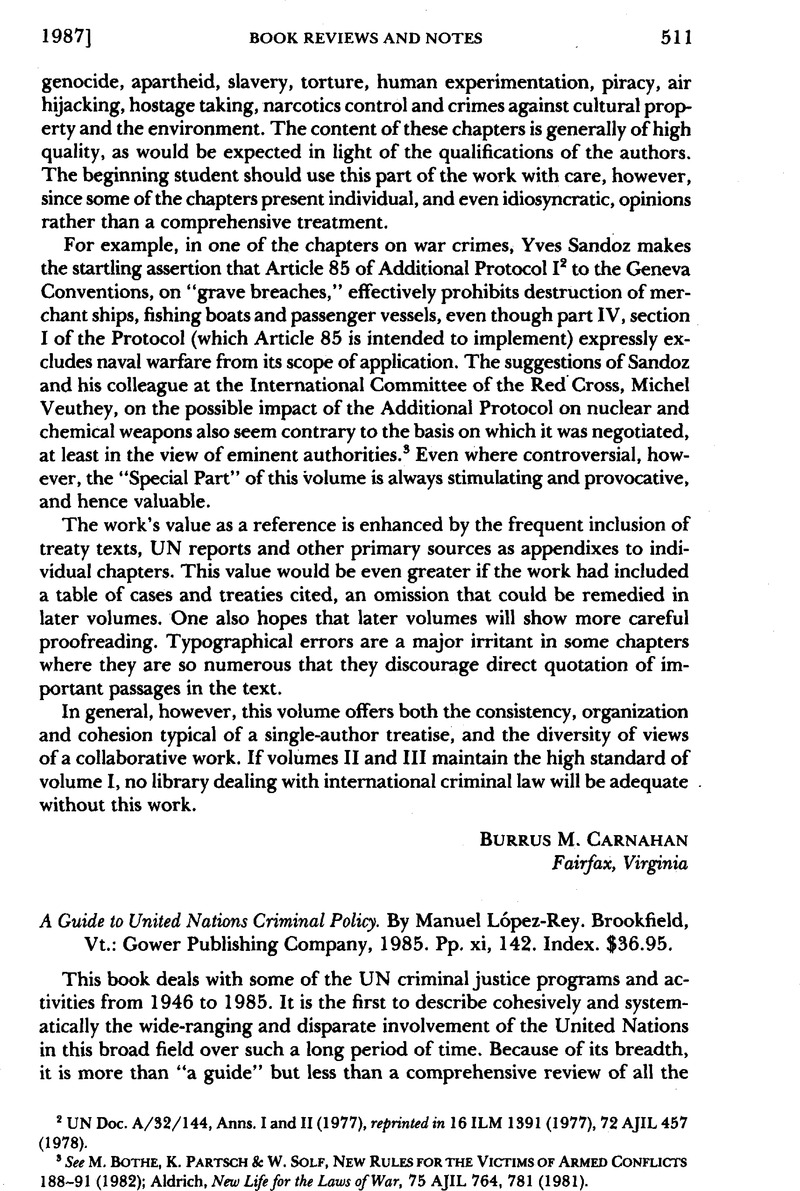No CrossRef data available.
Article contents
A Guide to United Nations Criminal Policy. By Manuel López-Rey. Brookfield, Vt.: Gower Publishing Company, 1985. Pp. xi, 142. Index. $36.95.
Published online by Cambridge University Press: 27 February 2017
Abstract

- Type
- Book Reviews and Notes
- Information
- Copyright
- Copyright © American Society of International Law 1987
References
1 See David, , Introduction in Crime and Criminal Policy: Papers in Honor of Manuel López-Rey y Arrojo (David, P. ed. 1985)Google Scholar.
2 See also Bassiouni, , The United Nations and Other International Organizations Active in the Field of Criminal Justice 6 Nouvelles Etudes Pénales 92 (1985)Google Scholar.
3 See, e.g., United Nations Activity in the Field of Human Rights, UN Doc. ST/HR/2/Rev.2 (1983).
4 But see Adler, F., Nations Not Obsessed with Crime (1984)Google Scholar.
5 Seventh United Nations Congress on the Prevention of Crime and the Treatment of Offenders, Milan, Aug. 26–Sept. 6, 1985, UN Doc. A/CONF.121/22/Rev.1; Report on the Ninth Session, Committee on Crime Prevention and Control, Vienna, Mar. 5–14, 1986, UN Doc. E/AC.57/1986/9; and also UN Doc. E/1986/INF/4 (1986); UN Doc. A/40/751 (1985).
6 See, e.g., Bassiouni, M. C., International Crimes: Digest/Index of International Instruments 1815–1985 (2 vols. 1985)Google Scholar.
7 See Bassiouni, , Characteristics of International Criminal Law Conventions in 1 International Criminal Law 5 (Bassiouni, M. C. ed. 1986)Google Scholar.
8 See also Bassiouni, , Report on the Scientific Activities of the International Association of Penal Law (AIDP) and its International Institute of Higher Studies in Criminal Sciences (ISISC) with the United Nations and Council of Europe 6 Nouvelles Etudes Pénales 101 (1985)Google Scholar.
9 The International Penal and Penitentiary Commission entered into an agreement with the United Nations to cede its functions, and that is how the United Nations became involved in the field of criminal justice; see GA Res. 415, 5 UN GAOR Supp. (No. 20) at 37, UN Doc. A/1775 (1950). The Commission then became the International Penal and Penitentiary Foundation. See López-Rey at 6–9.
10 See Bassiouni, supra note 8. The four major associations in the field of criminal justice have contributed to every congress a number of reports dealing with at least one, if not more, of the five agenda items of the congresses and organized a joint preparatory colloquium on one of the main congress topics for every congress since 1955. These organizations are the International Association of Penal Law, the International Society for Criminology, the International Society of Social Defence and the International Penal and Penitentiary Foundation. The work of other NGOs such as Amnesty International and the International Commission of Jurists, and of members of the Alliance of NGOs on Crime Prevention and Criminal Justice in New York and Vienna, is hardly mentioned by López-Rey except for a reference to the Alliance (p. 63) and the International Institute of Higher Studies in Criminal Sciences (Siracusa) (p. 94). The Institute also contributed significantly to the work of the Crime Prevention Branch and to the sixth and seventh congresses.
11 The resolution was adopted by ECOSOC and then by the General Assembly as the Declaration on the Protection of All Persons from Being Subjected to Torture and Other Cruel, Inhuman or Degrading Treatment or Punishment, and in 1984 the General Assembly adopted a resolution incorporating the Convention Against Torture and Other Cruel, Inhuman or Degrading Treatment or Punishment, UN Doc. A/RES/39/46. The original text of the Convention was prepared by a Committee of Experts under the chairmanship of this writer and Niall MacDertnot, Secretary-General of the International Commission of Jurists, which convened at the Siracusa Institute. The text was then submitted by the International Association of Penal Law to the Sub-Commission on the Prevention of Discrimination and Protection of Minorities, UN Doc. E/CN.4/NGO/213 (1978). See also 48 Revue International de droit Pénal, Nos. 3–4 (1977).
12 Standard Minimum Rules for the Treatment of Prisoners, adopted by the First United Nations Congress on the Prevention of Crime and the Treatment of Offenders, held at Geneva in 1955, and approved by the Economic and Social Council by its Resolutions 663 C (XXIV) of July 31, 1957 and 2076 (LXII) of May 13, 1977, reprinted in Human Rights: A Compilation of International Instruments, UN Doc. ST/HR/1/Rev.2 (1983). The sixth UN congress recommended measures for the implementation of the United Nations Standard Minimum Rules for the Treatment of Prisoners, UN Doc. A/CONF.87/11 (1980), which were prepared by this writer as a consultant to the Secretariat. ECOSOC adopted these measures in May 1984, on the recommendation of the Committee on Crime Prevention and Control at its 8th session, UN ESCOR Supp. (No. 6) at 50, UN Doc. E/1984/16. See also Bassiouni, , The U.N. Procedures for the Effective Implementation of the Standard Minimum Rules for the Treatment of Prisoners in Festschrift für Dietrich Oehler 525 (Herzberg, R. D. ed. 1985)Google Scholar.
13 See ECOSOC’s first regular session of 1986, May–June 1986, UN Doc. E/1986/92.


